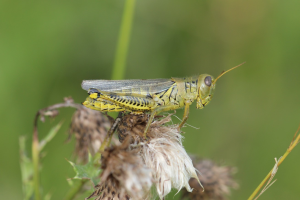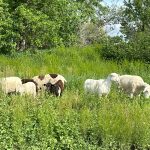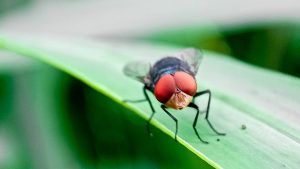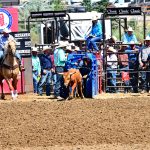Grasshoppers continue to cause losses

Hope for cold and wet
The predictions for winter weather in the Northern Plains varies wildly, from an early, cold, snowy winter to a milder, drier season. For landowners plagued with grasshoppers for six summers, Patrick Wagner, entomology field specialist, South Dakota State University Extension, says to hope for what is least pleasant for humans—a very cold and wet winter into a cool and rainy spring.
Wagner noted that the past two mild winters have resulted in abundant grasshopper eggs surviving. “In 2024 we had a long growing season and late frost which gave the grasshoppers an extended time to lay eggs. Then winter was mild which meant a high survival rate for adults.”
He had predicted the infestation and results of it would be awful when the grass dried out, but fortunately, much of the state had abundant rain in July and August which meant the grass kept growing resulting in plentiful forage for cattle and grasshoppers and grain crops experiencing less grasshopper damage.
“Earlier in the season, we saw problems in areas where road ditches or borders around the fields of wheat, barley or millet had been cut for hay. When that grass was disturbed, the grasshoppers simply started moving to the next green thing they saw, which was often a crop. In those cases, the insects were well beyond threshold levels,” Wagner shared.
“I am hoping some of our summer’s moisture causes a bacterial disease that affects grasshoppers, so maybe it has killed some of the population. However, the fact we are seeing less grasshoppers might just be an illusion,” Wagner said.
As grass begins to dry out in the autumn, challenges of sufficient forage may result as the voracious insects and cattle compete for the remaining forage.
Not all adult grasshoppers die as cold weather sets in. Wagner explained that grasshoppers lay eggs until the first hard freeze (less than 28 degrees).
“After that, most of the adults succumb to the elements and die. However, some manage to hunker down enough to survive as long as there is adequate snow cover (insulation) and temperatures do not drop below zero for multiple days. We have had back-to-back mild winters in South Dakota, and I have seen adult grasshoppers jumping around the past two springs. I hate to say it, but we could really use a harsh northern winter to knock them out this coming year,” said Wagner.
Montana State University Extension Forage Specialist Hayes Goosey understands the frustration that eastern Montana ranchers felt with another bumper of grasshoppers showing up in late spring this year. For landowners, this is the sixth year of watching the ravenous insects gobble grass, crops and even wooden fenceposts when lack of forage becomes especially dire.
Eastern Montana continues to experience an onslaught of ‘hoppers and for the last four years the bulk of them have surfaced in McCone County with substantial amounts further south in Yellowstone, Custer and Rosebud Counties.
Grasshopper infestations follow the drought cycle. “Grasshopper eggs survive better in a drought because their natural enemy to egg pods is a fungus. If you have dry soil at the right time you get an 80-percent survival for grasshopper eggs,” Goosey said. “This spring we had wet spots but with such a high load of eggs, but even with that moisture did not bring those levels back down. Last July and August were very dry as were early April and May this year. The weather that causes high mortality of eggs pods is a slow drizzle with cloud cover for a week with temperatures hovering in the 60s.”
Soil moisture is key. Goosey’s research showed that despite rain in the spring, the soil moisture remained low and temperatures high. Even a short cold, wet spell followed by a few searing days in the 90s did not allow the fungus to do its work.
The forage specialist added that bitter cold does not cause significant kill of egg pods.
“Most native insects in this region are cold resistant. You would have to have -15 for weeks to kill the egg pods. You might see a little more kill if it’s a dry winter, but the best bet to knock down a population is a cool, wet spring with good soil moisture,” Goosey said.
Grasshoppers especially like to feast on native prairie grasses and improved wheat grasses, such as crested wheat.
“The greatest problems occur when you have a high grasshopper population during a drought where there is not much forage anyway. When it’s a drought it’s first come first serve–whatever is green and growing is eaten,” Goosey said.
The eastern half of Montana has been an epicenter for grasshoppers for the past several years which corresponds with the drought data. Grasshoppers lay eggs in the top couple inches of soil which is the first to dry out. The first hatch is in the middle of April with most hatching in May and through the first of June.
Goosey noted, “This spring we had rain but not at the right time and it was not persistent or long enough. In June, our subsoil moisture was at 5 percent. You need at least 15-18 percent subsoil moisture to cause mortality in the eggs. We saw subsoil moistures levels increase to 25 percent at one point, but then the temperature quickly jumped to 95 degrees which promptly cooked off that moisture.”
He added that even the rains this summer were not sufficient to knock back next year’s grasshopper population.
Even though the thought of snow shovels and insulated coveralls, followed by slogging around in the mud, does not sound appealing to humans, those unpleasant conditions may have one positive result–mortality in wintering adults and grasshopper eggs pods. It might be worth praying for cold and wet if some folks don’t want year seven of ‘hoppers.






